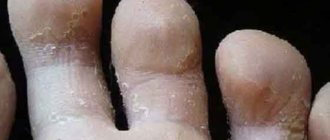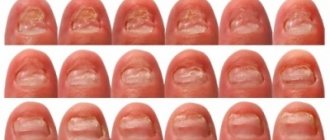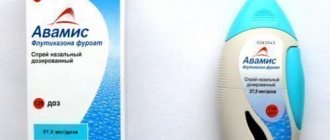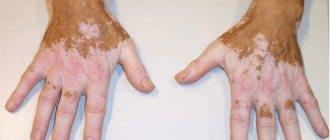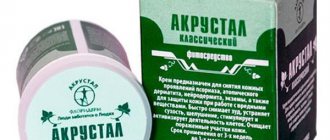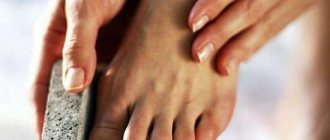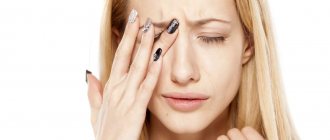Almost every person has encountered a fungal infection, and knows that it is very difficult to get rid of it. To cure a disease you need to spend a lot of time, effort and money, especially at an advanced stage of the disease. Let's look at how to treat foot fungus at home so that you can forget about the disease as soon as possible.
Fungus on the feet and treatment methods
General rules
Therapeutic and hygienic measures must be carried out regularly; treatment cannot be interrupted until the fungus is completely eliminated. The duration of the recovery process depends on the degree of neglect of the disease and the affected area. Read also: Fungus on the fingers: treatment and symptoms with photos.
For a successful outcome of treatment and prevention of infection of others, it is recommended to follow the basic rules:
- For the entire period of treatment, you should avoid visiting swimming pools, saunas, beaches, and pedicure rooms.
- The patient must have individual means for hygienic treatment of feet: files, pumice stones, soap, towels, etc.
- Shoes must be thoroughly disinfected and dried. Insoles and the inner surface of shoes can be treated with special solutions or sprays.
- Feet must be dry at all times. Fungal pathogens actively reproduce in warm and humid environments. After water procedures, feet should be dried with a clean towel, and if the feet are sweating, use talcum powder, powders and powders.
- Particular attention is paid to hosiery. It is better to choose socks made of natural cotton. This material absorbs moisture well and ensures normal ventilation of the skin of the feet. Socks should be changed as often as possible, and used items should be boiled.
- Drug treatment is carried out strictly in accordance with the instructions of the attending physician after confirmation of the diagnosis by the results of laboratory tests of the infected material.
The keratinized skin of the fingers and soles must be constantly removed with a special foot brush or pumice stone. Otherwise, cracks may form through which the fungus penetrates into the deep layers of the epidermis and the bloodstream.
Preference should be given to comfortable shoes made from natural materials to prevent the accumulation of excess moisture.
Types of nail fungus
Fungi Dermatophytes
There are many types of this fungus, they are known for easily adapting to any microclimate. In nature, they live in the soil; infection can occur from humans and animals, as well as through direct contact with a fungus living on the surface of the soil. But it is quite difficult to become infected with this species, since there are always several factors that provoke the disease.
We list the most common types of dermatophytes:
- Trichophyton rubrum. It initially infects the end of the nail, then reaches the base. The nail plate collapses, becomes soft and thick, and the color turns yellow. The dermis in the affected area dries out and peeling forms.
- Trichophyton mentagrophytes. This fungus loves a warm and humid microclimate, so infection usually occurs in such places, especially in public ones. It affects the nails of the big toes and the area around them, accompanied by itching, inflammation, and papules.
The fungus gradually reaches the base of the nail, in which case it is very difficult to cure. Nails peel, break, crumble, sometimes even leading to complete loss of nails.
Candida fungus
This type of fungus is especially familiar to the female part of the population, since at least 8 out of 10 women have at least once suffered from thrush caused by a fungus of the Candida species. This fungus is normally present in the body of all people, but various provoking factors can accelerate its reproduction and cause pathology.
If candida is localized on the nails, then infection most likely occurred through contact with an object used by the infected person - a towel, shoes, scissors, a washcloth. On the nail plate, it initially develops at the base, so its growth slows down. This type most often develops on the fingernails.
Molds
This is the most dangerous of the presented types of fungus. It affects not only the skin, but also develops throughout the body at a high rate. Infection occurs when the nail plate or skin fold is destroyed. Fortunately, the risk of contracting this variant is very low. But it can only be cured with special drugs for mold nails, since the usual ones (for candida and dermatophytes) do not work.
Foot baths
Therapeutic baths are a must in the treatment of fungal diseases of the feet at any stage of development of the infectious process. Procedures for steaming the feet in hot water with the addition of various active ingredients are a preparatory stage before applying the main antifungal drugs.
Foot baths can be used twice a day or daily before bed. The duration of the procedure depends on the composition of the bath, but does not exceed a half-hour threshold.
Healing herbs
For antifungal foot baths, decoctions of medicinal herbs are used:
- plantain;
- wormwood;
- burdock;
- milkweed;
- yarrow;
- calendula flowers.
Herbs can be combined or steamed separately. For the best effect, the decoction should be strong enough. The required amount of plant material must be poured with boiling water. As soon as the temperature of the decoction becomes tolerable for the skin, you can put your feet in the bath and steam your feet for 15-20 minutes.
Celandine
Celandine preparations are often used in the fight against foot fungus. To prepare foot baths, it is recommended to use dried celandine herb. You can buy it at the pharmacy or prepare it yourself.
The decoction is prepared at the rate of 8 tablespoons of herb per 2 liters of boiling water, then cooled to a temperature of 50˚C and placed in a convenient container. Feet should be kept in the bath until it cools down. The course of treatment is 20 days.
Vinegar
An acidic environment has a detrimental effect on pathogenic microflora that causes mycoses. Baths with vinegar essence are used as an effective treatment for foot fungus at home using folk remedies.
Vinegar is taken at the rate of 100 ml of essence per 2 liters of warm water. The estimated duration of the procedure is a third of an hour. Such a home remedy for fungus can significantly speed up the treatment carried out with modern pharmaceuticals.
Soda and salt
Salt and soda solutions for soaking the feet allow you to fight foot fungus in the initial stage. There are a lot of options for preparing foot baths with salt and soda at home. The simplest and most effective recipes:
- Dissolve 2 tablespoons of table salt and baking soda in two liters of warm water and soak your feet for up to 20 minutes.
- To two liters of boiling water add a similar amount of strong oak bark decoction, a few drops of peppermint oil and tea tree essential oil, 2 tablespoons of soda, 2 tablespoons of sea salt. The duration of steaming is half an hour. The treatment period takes 14 days.
- Mix 1 heaped tablespoon of soda and coarse salt in warm water, add a couple of tablespoons of liquid soap with an antibacterial effect (you can use tar). Steam your feet in the prepared solution for up to half an hour; at the end of the procedure, let your feet dry without wiping or rinsing with clean water.
Salt helps strengthen nails and regenerate epidermal tissue, and soda softens the skin, cleansing and disinfecting the surface of the feet. Salt solutions containing iodine have a pronounced fungicidal effect.
Foot steaming with vodka, ammonia, propolis, strong coffee, birch tar, hydrogen peroxide and garlic juice helps perfectly.
Treatment methods
Treatment for onychomycosis must begin immediately after the problem is detected. If you delay treatment, a complication may occur: infection of neighboring fingers, transition to a chronic form and progressive course of the disease. Therefore, always make an appointment with your doctor if you notice any suspicious changes or use time-tested traditional methods.
Folk remedies for fungus
In the initial stages of the disease, home remedies to combat fungal infection are helpful. To get rid of fungus, you can try the following recipes:
- Tea tree oil. The mixture is a powerful natural antiseptic and fungicide. It is applied drop by drop to the affected area 2 times a day. The duration of the course is 21 days.
- Apple vinegar. Foot baths are prepared from it, mixed in equal parts with water.
- Iodine for fungus. An old proven way to get rid of fungal nail infections. Directions for use: Apply 1-2 drops of the composition to the affected area once a day. In order to prevent infection of neighboring fingers, it is recommended to lubricate them with iodine, but less often - once every 2-3 days.
- Listerine mouthwash. It contains an antiseptic and a small amount of alcohol, which have a detrimental effect on the treatment process.
- Lemon juice. It is applied as a compress for 30 minutes. to the affected areas.
Food restrictions during treatment have a positive effect. You should exclude sweets and starchy foods from your daily diet, increase the amount of protein (beef, fish, poultry) and fermented milk products (yogurt, kefir, cottage cheese). Fruits should also be unsweetened (lemon, grapefruit, sour apples, raspberries, cherries). The diet is necessary to strengthen human immunity and reduce the concentration of the nutrient medium for the fungus - simple sugars that are formed in the body when consuming easily digestible carbohydrates.
Modern medicines and procedures
Unfortunately, treating fungal infections at home is often ineffective. This is due to the fact that the disease has already entered a progressive form. To get rid of it you need to see a doctor. The effectiveness of medical therapy depends on the duration of the course, which takes several months even after the elimination of visual symptoms. But patients forget that they need to continue the course after the cosmetic effect occurs. This leads to relapse and the need for treatment from the very beginning.
In the early stages, when the tissue changes are minor, a fungicidal ointment will help. For advanced cases, oral medications are usually prescribed. Foot fungus is prone to recurrence, so after recovery, follow your doctor's recommendations. In general, the duration and order depend on the species that infected the nails, the clinical course, the number of infected nails and the degree of damage to the plate. In some cases, a systematic approach combining several methods is required. The combination of systemic and local effects improves the effectiveness of therapy.
Topical antifungal ointments
Topical medications should be used only in cases where the lesion occupies less than half of the distal part of the plate and when the patient does not tolerate systemic treatment. Ointments and suspensions include amorolfine, ciclopirox and bifonazole, urea. They are used daily for 5-12 months. The last option for topical treatment of onchomycosis is bifonazole in combination with a 40% urea solution.
But external remedies cannot help to heal completely because they do not penetrate the tissues enough. It was found that although the latest generation of ointments cover all layers, they still have low effectiveness when used as a single preparation. However, these agents may be useful as adjuvant therapy, complementing oral medications, or to prevent relapse in patients who have previously taken oral medications.
Antifungal tablets
Oral treatment in case of ringworm is almost always necessary. New generations of antifungal drugs, such as itraconazole or terbinafine, have recently replaced older generic drugs in the treatment of nails. The effectiveness of these products is explained by their ability to penetrate the nail plate in just a few days after the start of the course. By using them, you can afford a shorter duration of therapy with a high recovery rate and fewer side effects. Terbinafine (international name, you should look for commercial analogues in the pharmacy), fungicides (kill the pathogen) cure the disease and prevent the subsequent spread of spores. These medications work against both yeast viruses and dermatophytes, the most common causes of nail fungus.
Surgical treatment of onychomycosis
This method can also be used to treat fungal nail infections. It involves mechanical and chemical removal of the infected nail plate (using 40-50% urea). This is a painless and useful method when the growth is very thick and interferes with the patient's comfort.
Nail plate removal for onychomycosis should be considered as adjuvant therapy in patients treated with oral agents. A combination of oral, topical (lubricant) and surgical treatment of fungus leads to the highest cure rate and is at the same time the cheapest option (lowest number of relapses, short course).
Laser therapy
A new method showing the greatest efficiency. In just 4 sessions of irradiation with a “cold” laser, you can completely get rid of the problem. The only drawback of this type of influence is the relatively high cost of the procedures.
Compresses, rubbing, lotions
You can remove foot fungus using compresses and various rubs according to alternative medicine recipes. The procedure is carried out after thorough treatment and steaming of the legs.
The healing mass is applied to the affected area, fixed with a gauze bandage and insulated on top with clean socks. Provided there are no aggressive substances in the compress, the bandage is left overnight.
The most popular recipes for homemade antifungal compresses for the treatment of mycoses of the feet:
- Apply finely chopped fresh rowan leaves to the infected skin, cover with a burdock leaf on top and wrap in cellophane.
- Apply 35% salicylic ointment evenly to the fungal lesions and cover with cling film. Change the bandage once a day.
- Pass a few cloves of garlic through a press and mix with an equal amount of butter until smooth. Apply the resulting mass to the sore spot, cover with film, and leave overnight. Garlic will sting, but it is a good way to quickly cure foot fungus.
- Onion pulp is used for compresses in its pure form; you just need to change the dressings as often as possible. If the itching becomes unbearable, you can dilute the onion with Vaseline in a 1:1 ratio.
- Night vinegar compresses show good results. It is more convenient to use a cotton pad soaked in a weak solution of vinegar essence.
- Alcohol wraps help against foot fungus. A small piece of linen fabric soaked in an aqueous solution of ammonia is wrapped around the sore leg and insulated with polyethylene. The course lasts 7-10 days.
- Mashed potato sprouts are infused with vodka for 24 hours. The prepared pulp is used for foot compresses before bed.
- If the fungus is localized in the interdigital folds, you can apply a paste of peppermint herb and salt to the affected skin. This product perfectly combats itching, removes unpleasant odor and other symptoms.
The method of rubbing the affected skin with birch tar, an alcohol solution of iodine, garlic juice, tea tree and celandine oils helps to quickly get rid of foot fungus at home.
Many pharmaceutical local antifungal drugs are recommended for use in the form of compresses if mycosis has reached an advanced stage.
What you need to know about fungus
Foot fungus is a contagious infectious disease that affects human skin and nails. Most often, adults and elderly people suffer from this disease. The infection takes root well in warm and humid places: baths, saunas, showers. You can become infected by visiting public places barefoot, when trying on shoes and during a pedicure, or by insufficient sterilization of instruments.
On a note!
Mycosis develops when the immune system is weakened and when infection gets into wounds or cuts.
The fastest way to get rid of fungus is to start treatment when the first signs of the disease appear. Diagnosing mycosis on your own is quite difficult, especially at the initial stage. Usually the infection does not manifest itself in any way, but then itching, an unpleasant odor from the feet, peeling and discoloration of the nail appear. As soon as you notice any of these symptoms, consult a dermatologist immediately. After a visual examination and tests, he will be able to confirm the exact diagnosis and then write out a detailed treatment plan.
If you don’t start fighting the disease, you may be left with no nails at all. At the initial stage, the doctor will prescribe medications and traditional methods that can be used at home to treat mycoses.
Antimycotic drugs
The fastest way to cure a mycosis infection is the right combination of folk remedies and antifungal drugs. Medicines for fungal diseases are divided into two main groups: for local and systemic use.
Oral antimycotics are prescribed for drug therapy of fungus in an advanced form in the absence of contraindications. Taking tablet medications is associated with a risk to the liver; they should be taken only in the dosage prescribed by your doctor. Systemic antifungal drugs include:
- Ketoconazole;
- Intraconazole;
- Candithral;
- Terbinafine;
- Griseofulvin and numerous of their analogues.
The choice of local medicines depends on the species of the causative agent of the disease and the financial capabilities of the patient. It may take several months to remove the fungus, and not everyone can buy expensive drugs.
Preparations for external use are available in the form of creams, gels, ointments, sprays, varnishes and solutions. Well-known pharmaceutical companies produce entire series of products for the complex treatment of fungus.
Regardless of the form, brand and price category, the main difference is the type of active ingredient of the drug. It is this criterion that determines the effectiveness of the drug against a specific type of infectious agent.
Antifungal drugs contain fungistatic substances: sertoconazole, bifonazole, ketoconazole, oxyconazole, terbinafine, ciclopiroxalamine, amorolfine.
It is easier to defeat foot fungus with the help of local medications in the early stages of the disease when the first signs of infection appear, if treatment is carried out continuously in accordance with the attached instructions.
Damage by mold fungi
Molds cause fungi much less frequently than Candida or dermatophytes. The main symptom of toenail infection with mold is, as can be seen in the photo, a change in the color of the nail plate to blue, black, or greenish.
Signs of mold fungus on the toenails can be dark spots, dots on the nail plate, or, as in the photo, a black longitudinal stripe.
We recommend that you read the article Mold and candidal onychomycosis.
Rules of personal hygiene as prevention against foot fungus
Prevention of foot fungus is, first of all, personal hygiene measures aimed at preventing infection and creating an environment hostile to microorganisms.
It is important to remember that mycotic lesions of the feet can last for a long time, almost without manifesting themselves; they are characterized by a chronic relapsing course.
Pathogenic microorganisms that affect the foot are unusually tenacious; they love dampness, damp, unventilated interdigital folds of the feet, the lower and lateral surfaces of the sole.
Below is a short list of personal hygiene rules (well known, however, not always followed) to avoid catching this obsessive infection:
- Keep your feet dry and cool;
- Do a pedicure in a timely manner using tools that have undergone proper disinfection, using modern auxiliary and care products;
- Wash your feet with warm soapy water daily, use antibacterial soap if necessary, wash your feet several times a day;
- Wipe your toes dry from the base to the very tip, the skin between the toes, and the entire foot;
- Fight sweaty feet;
- Use antifungal foot powders, and, if necessary, antifungal cosmetic and medicinal creams, gels, nail polishes;
- Go barefoot, at least at home, in the country;
- Keep your toes slightly apart;
- In locker rooms, showers, gyms, fitness clubs and other public places, do not walk barefoot - wear flip-flops (rubber slippers, waterproof flip-flops);
- Do not use someone else’s sponge, washcloth, towel, slippers (even within the family);
- If infected, provide a separate towel for the affected area or use disposable paper towels;
- Wear comfortable shoes that fit properly, made of leather and other natural materials;
- Avoid rubber and plastic shoes - a favorable environment for the growth of dermatomycetes;
- Keep your shoes clean and dry, ventilate them, treat the inside of your shoes with antifungal powder or aerosol;
- In summer, wear light, well-ventilated shoes;
- Change your sneakers in a timely manner; if they can be washed, wash them at least once a month;
- Change socks (socks, stockings, tights) more often, especially with hyperhidrosis, more often if necessary;
- Wear socks made of hygroscopic materials (natural fibers or special synthetics);
- To kill fungal spores, wash socks twice in very hot water; rinse your socks thoroughly after washing to remove the washing powder so as not to worsen the condition of the skin;
- For proper sanitary and hygienic condition of sinks, showers, bathtubs, basins, wash them regularly, use special products;
- Do not self-medicate, consult a doctor in the early stages of a fungal disease; do not expose others to the risk of infection;
- Be especially careful if you have fungal diseases in your household;
- Help elderly family members comply with dermatological orders and the necessary sanitary and hygienic requirements aimed at treating this disease.
Nail fungus. Symptoms
Fungus on the nails has pronounced symptoms and signs, photos and pictures of the initial and advanced stages of which can be viewed on the website.
Symptoms of onychomycosis vary. The most common manifestations are dryness and peeling of the epidermis around the nail plate, inflammation, and swelling.
As the disease progresses, the nail becomes yellow and stripes and spots appear on it. The nail plate thickens, becomes thinner, softens, crumbles, breaks. Depending on the type of disease, the symptoms and stages of their manifestation differ.
- With vesicular, the feet are first affected, they become covered with papules with fluid, and the disease gradually spreads.
- With membrane, the nail and ring toes are initially affected, the skin becomes inflamed, itchy, and peels.
- With moccasin-like fungus, the heels and areas of skin around them first become infected, pain appears in the feet, and the dermis cracks.
- Interdigital is localized in the area between the fingers.
Soon these symptoms reach the nails.
With complications of the fungus, the nail plate weakens so much that it can fall out on its own. To prevent this, timely treatment must be started. You need to start with a visit to a dermatologist, he will establish a diagnosis and prescribe appropriate treatment.
Symptoms do not differ from age, but depend only on the type, stage and location of the fungal infection. It is prohibited to make a diagnosis yourself, since the symptoms are similar to other dermatological diseases.
Giving up bad habits is a significant contribution to the prevention of foot fungus
Bad habits (excessive alcohol consumption, smoking, drug addiction), improper wakefulness-sleep, work-rest patterns, inappropriate behavior in stressful situations usually lead to a serious decrease in immunity and poor circulation.
Unreasonable unbalanced nutrition, excessive consumption of light carbohydrates, physical inactivity lead to obesity. Against the background of weakened immunity, poor circulation and obesity, a favorable climate is formed for infection and the development of infection into a generalized dangerous disease.
This indicates an urgent need to give up bad habits.
Prevention
To recognize the problem in time, you should know what the fungus looks like. To do this, it is better to inquire about this issue in advance by looking at photos on the Internet. Then you need to listen to the advice of dermatologists on what to do to avoid getting infected with foot fungus:
- after visiting the beach, swimming pool and other public places, you should thoroughly wash your feet;
- when your feet sweat, there is a risk of becoming infected with mold, so you should avoid wearing socks and closed shoes for long periods of time;
- in order to avoid becoming infected with pathogenic microflora, you should not give personal hygiene items, clothing or shoes to others;
- You should regularly care for your toes: get a pedicure, trim overgrown nails.
Folk and pharmacy remedies for the prevention of foot fungus
When choosing folk remedies for the prevention of foot fungus, you should remember that fungi do not like an acidic environment; to stop the growth of fungi, a slightly acidic environment (pH 5.5) is sufficient. For preventive purposes, it is advisable to periodically:
- Treat your feet with diluted lemon juice or fermented milk products (kefir, yogurt, etc.)
- Make baths with salt water (2 tablespoons of salt in 0.5 liters of water) or light vinegar water (1 glass of table vinegar in 3 - 4 liters of water) or soda water (1 tablespoon of sodium bicarbonate in 1 liter of water).
